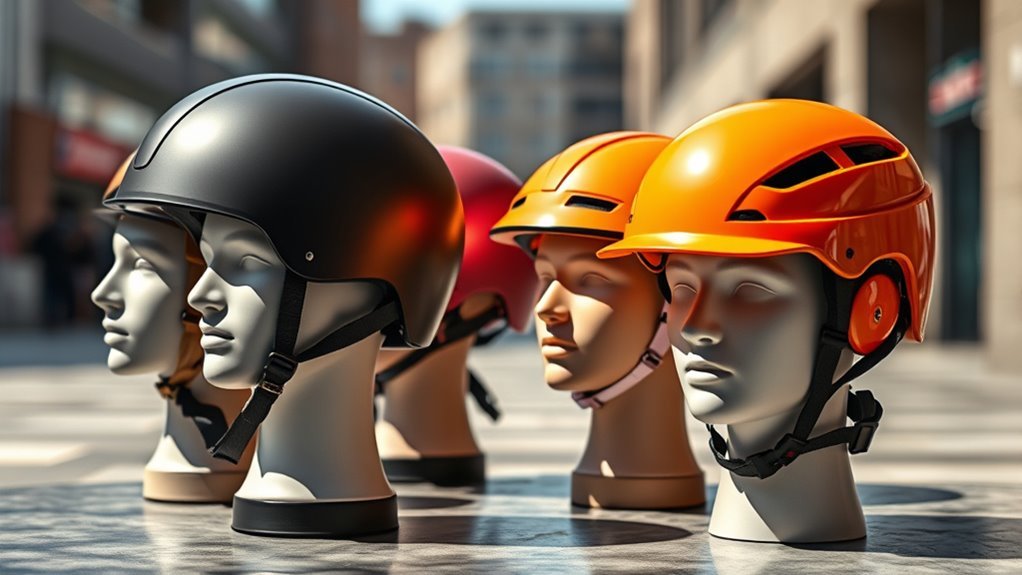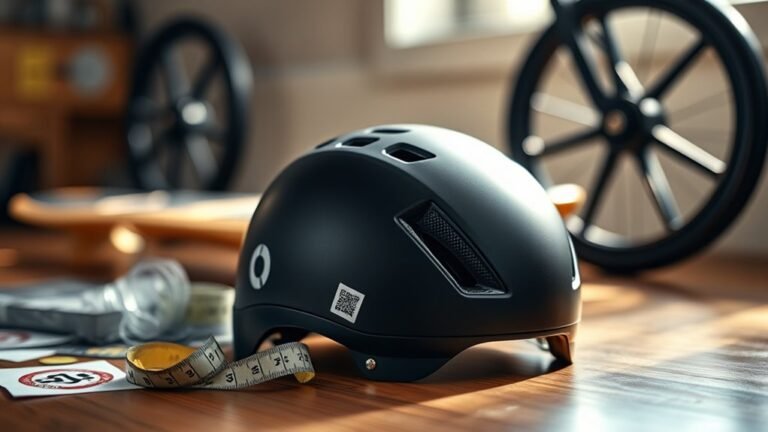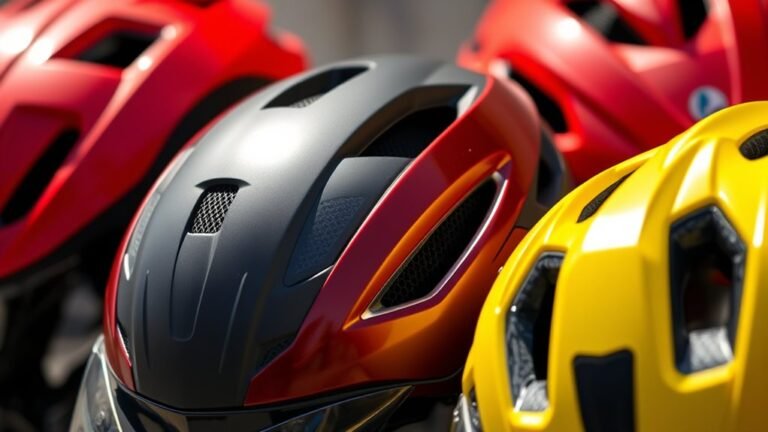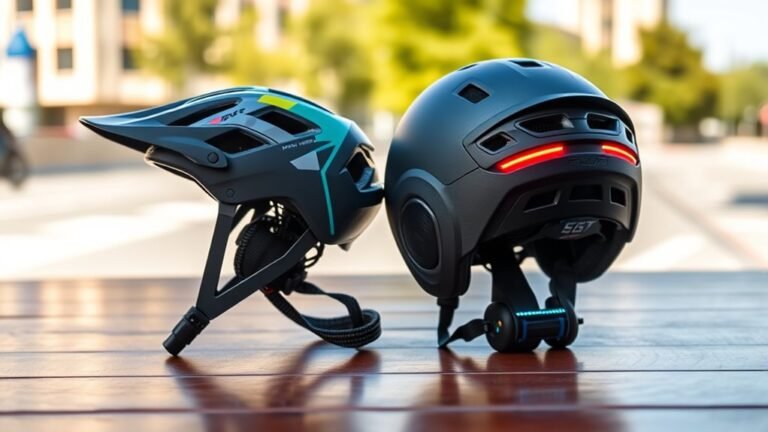Helmet Fit for Different Head Shapes in Urban Helmets
To guarantee your urban helmet fits properly, identify your head shape—round, oval, or intermediate. Round heads need helmets with circular interiors, while oval heads require longer, narrower designs. An intermediate shape blends features from both. A snug, well-fitted helmet enhances comfort, safety, and stability, promoting effective impact absorption and unobstructed vision. Don’t overlook breathability and adjustable retention systems for added comfort. Learning more about specific helmet brands tailored to your head shape can further enhance your cycling experience.
Understanding Head Shapes: Round vs. Oval vs. Intermediate
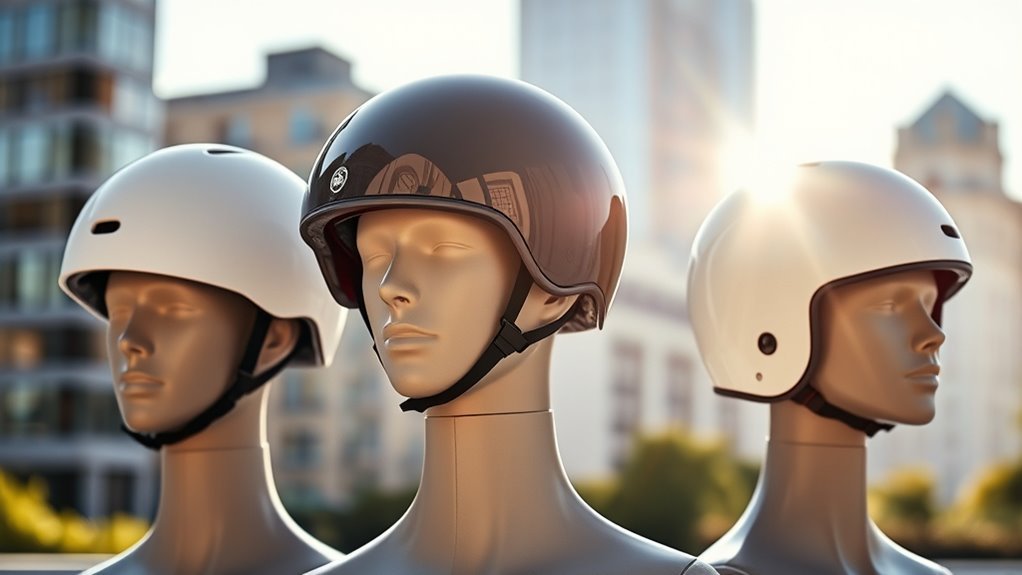
When it comes to helmet fit, understanding the three primary head shapes—round, oval, and intermediate—can make all the difference in comfort and safety. If you’ve got a round head, you’ll likely find that helmets with a more circular interior shape provide a snug fit. Conversely, if you have an oval head, look for helmets designed with a longer, narrower profile to accommodate your shape better. Intermediate head shapes fall somewhere in between, offering a blend of both designs. The right fit isn’t just about comfort; it’s essential for safety during your rides. So, take a moment to identify your head shape, ensuring you choose a helmet that allows you to enjoy your freedom on the road without compromise.
The Importance of Proper Helmet Fit
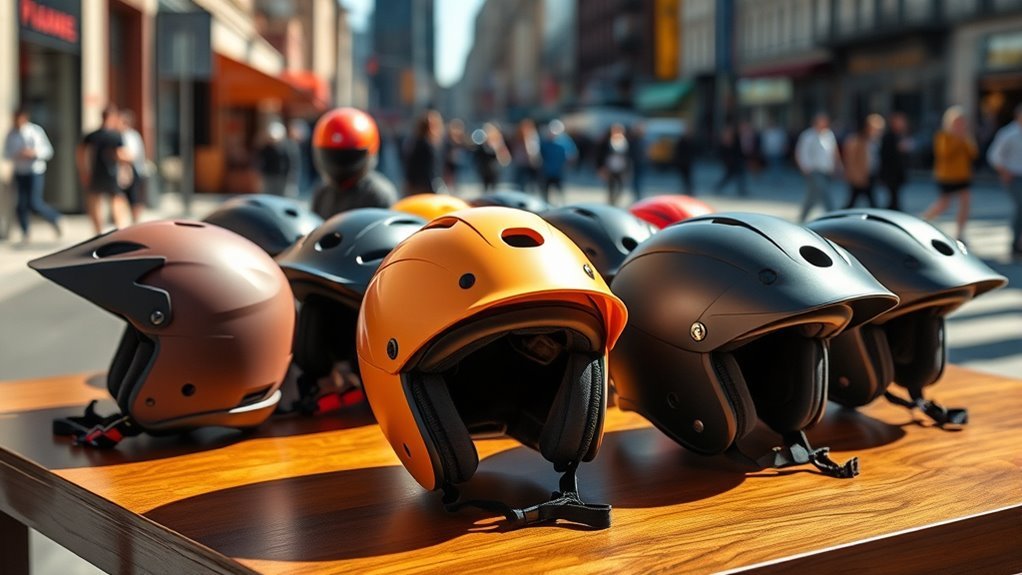
Proper helmet fit is essential for ensuring your safety and protection during any activity. A well-fitted helmet enhances comfort and wearability, making it more likely that you’ll wear it consistently. Additionally, adjustability for different head shapes allows for a secure fit that maximizes effectiveness.
Safety and Protection
Although many people underestimate the importance of a well-fitted helmet, its role in ensuring safety during various activities is essential. A helmet that doesn’t fit properly can compromise your protection, making it necessary to adhere to helmet standards and safety regulations. Here are three key points to remember:
- Impact Absorption: A snug fit allows the helmet to absorb impact energy effectively, reducing the risk of head injuries.
- Stability: Properly fitted helmets remain securely in place during movement, ensuring they provide continuous protection.
- Visibility and Awareness: A well-fitted helmet won’t obstruct your vision, allowing you to stay aware of your surroundings, which is vital for safety.
Investing time in finding the right fit can greatly enhance your safety while enjoying your freedom on the road.
Comfort and Wearability
Guaranteeing a helmet fits comfortably is essential for prolonged wear, especially during activities that demand focus and attention. A proper fit enhances your experience, allowing you to enjoy freedom without distraction. Look for helmets that incorporate breathable materials and customizable padding, which improve airflow and provide a personalized fit.
| Feature | Benefits |
|---|---|
| Breathable Materials | Reduces perspiration, enhances comfort |
| Customizable Padding | Tailors fit to your head shape, preventing pressure points |
| Lightweight Design | Promotes wearability, easy to carry |
| Ventilation Systems | Enhances airflow, keeps you cool |
Choosing a helmet that prioritizes comfort guarantees you stay focused on your ride while enjoying the freedom of movement.
Adjustability for Shapes
A well-fitted helmet can greatly impact your safety and comfort during rides, especially if your head shape differs from standard designs. Customizable fittings are essential for ensuring that your helmet accommodates your unique head shape. Here are three key benefits of using shape-specific designs:
- Enhanced Safety: A snug fit minimizes movement, reducing the risk of injury during impacts.
- Improved Comfort: Proper adjustability means less pressure points, allowing for longer rides without discomfort.
- Personalized Style: With various customizable options, you can express your personality while ensuring a secure fit.
Investing in a helmet with adjustable features tailored to your head shape isn’t just about aesthetics; it’s a crucial step towards maximizing your freedom and safety on the road.
Features to Consider for Urban Cycling Helmets
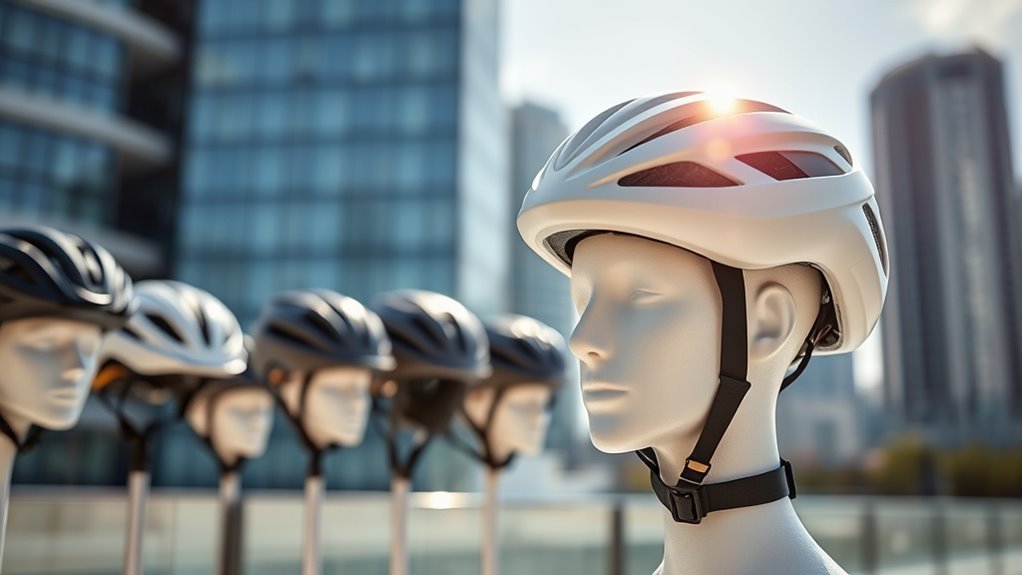
When choosing an urban cycling helmet, you need to take into account head shape compatibility to guarantee a secure fit. Additionally, adequate padding and comfort are essential for longer rides, while adjustable retention systems enhance stability during your commute. Evaluating these features will help you select a helmet that meets both safety and comfort needs.
Head Shape Compatibility
Finding the right helmet for urban cycling requires understanding how different head shapes impact fit and comfort. Recognizing head shape variations is essential for selecting the appropriate urban helmet styles. Here are key factors to take into account:
- Shape Compatibility: Determine if your head shape is round, oval, or intermediate, as this influences helmet design.
- Adjustability Features: Look for helmets with adjustable retention systems to fine-tune fit based on your unique shape.
- Ventilation Design: Verify the helmet provides adequate airflow while conforming to your head shape, enhancing both comfort and safety.
Padding and Comfort
Choosing the right padding in a helmet can greatly impact your comfort during urban rides. The use of advanced padding materials and comfort technology can enhance your experience, reducing fatigue and increasing safety. Here’s a breakdown of popular padding options:
| Padding Material | Comfort Level | Breathability |
|---|---|---|
| Foam | High | Moderate |
| Gel | Very High | High |
| Memory Foam | High | Moderate |
| EVA Foam | Moderate | High |
| Air Pads | Very High | Very High |
When selecting a helmet, consider how these materials affect your comfort. A well-padded helmet not only fits snugly but also guarantees you can enjoy the freedom of urban cycling without discomfort.
Adjustable Retention Systems
An effective adjustable retention system is essential for guaranteeing a secure and comfortable fit in urban cycling helmets. You’ll want to pay attention to the following features when evaluating retention mechanisms:
- Adjustable Straps: Guarantee they provide a snug fit without pinching or discomfort, allowing for easy adjustments on the go.
- Dial Systems: Look for a convenient dial that enables precise adjustments, giving you a customized fit that adapts to your head shape.
- Y-Strap Design: A well-constructed Y-strap distributes pressure evenly, enhancing stability and comfort during rides.
How to Measure Your Head for the Perfect Fit
Measuring your head accurately is essential for selecting a helmet that offers both comfort and safety. To begin, use a soft measuring tape and wrap it around the widest part of your head, just above your ears. Make sure it’s snug but not too tight. Record the measurement in centimeters or inches. This is your head size. Next, consult helmet sizing charts provided by manufacturers, as sizes can vary. For greater precision, consider using head measurement techniques, such as measuring the length and width of your head, to account for different head shapes. With these accurate measurements, you’ll be well-equipped to choose a helmet that fits perfectly, allowing you the freedom to ride safely and comfortably.
Adjusting Your Helmet for Optimal Comfort and Safety
To guarantee your helmet provides the best fit and protection, it’s vital to make necessary adjustments after selecting the right size. Proper helmet positioning and strap adjustment are important for ideal comfort and safety. Follow these steps to confirm your helmet fits perfectly:
Ensure your helmet fits perfectly by adjusting its position and straps for optimal comfort and safety.
- Position the Helmet: Place the helmet level on your head, about two finger-widths above your eyebrows.
- Adjust the Straps: Fasten the chin strap snugly, making sure it’s tight but comfortable, allowing only a slight gap between your chin and the strap.
- Check for Movement: Shake your head gently; the helmet should stay in place without sliding.
Recommended Helmet Brands for Different Head Shapes
Finding the right helmet brand can greatly enhance your safety and comfort, especially when evaluating the unique shapes of your head. For those with round heads, brands like Giro and Bell offer excellent shape recommendations, providing a snug fit. If you have an oval head, look into Kask or Specialized, as their designs cater specifically to this shape. For a more elongated head, brand comparisons suggest trying out Lazer or Nutcase. Each brand tailors their helmets to specific head shapes, ensuring ideal comfort and protection. Don’t forget to examine features like ventilation and weight, as they can also affect your riding experience. Ultimately, choosing the right brand will empower you to ride freely and confidently.
Frequently Asked Questions
Can I Wear a Hat Under My Helmet for Added Comfort?
Yes, you can wear a hat under your helmet for added comfort, but it’s essential to verify hat compatibility. A thin, moisture-wicking cap can enhance comfort without compromising the helmet’s fit or safety performance. However, avoid bulky hats, as they might interfere with the helmet’s snugness, reducing its protective capabilities. Always prioritize a secure fit, making sure your helmet stays in place during rides while maximizing comfort enhancement through minimal layering.
How Often Should I Replace My Urban Helmet?
Think of your helmet as a trusty steed; it needs care and timely replacement to keep you safe on your urban adventures. Generally, you should replace your helmet every three to five years, depending on usage and wear. Look for replacement indicators like cracks, dents, or a loose fit—these are signs your helmet’s lifespan is ending. Remember, a well-maintained helmet guarantees you ride freely while staying protected from unexpected falls.
Are There Specific Helmets for Long Hair?
Yes, there are helmets designed to accommodate long hair. Look for models with hair padding or adjustable features that allow for a comfortable fit. These helmets often have a rear opening or a ponytail port, giving you the freedom to wear your hair up without compromising safety. When fitting, make sure to make necessary helmet adjustments so it sits securely on your head while allowing your hairstyle to fit comfortably.
What Materials Are Best for Urban Helmets?
For urban helmets, the best materials combine durability and comfort. Look for a hard outer shell made from polycarbonate or fiberglass for impact resistance. Inside, various foam types like EPS (expanded polystyrene) provide excellent energy absorption. Some helmets feature dual-density foam, enhancing comfort and safety. These materials together guarantee you’ve got a helmet that protects effectively while still allowing you the freedom to ride confidently through city streets.
How Can I Clean and Maintain My Helmet?
To clean and maintain your helmet, start by removing the inner padding and hand-washing it with mild soap and water. For the outer shell, use a damp cloth to wipe away dirt and grime. Avoid harsh chemicals that can damage the materials. Regularly check for any cracks or wear, as helmet care is essential for safety. Following these cleaning tips will help guarantee your helmet remains in top condition for your urban rides.
